Content
OT-hybrid lilies are a type of crop that has numerous advantages. It is grown in almost all countries of the world and is considered a giant, as it can grow up to 2 m tall or even more. One stem of such a lily looks like a full-fledged bouquet and delights everyone around.
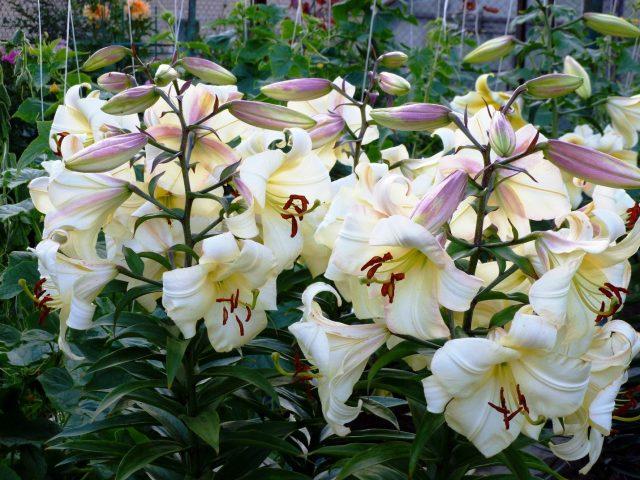
Nowadays, lilies with cup-shaped buds are being created based on OT hybrids
What does lily OT-hybrid mean?
Lily OT-hybrid stands for “Oriental Trumpet”. This is a variety that was obtained by crossing trumpet and oriental specimens. The first OT hybrid variety appeared in the United States of America in 1957 and was named Black Beauty. Despite the fact that the variety is not new and has existed for several decades, it is still in demand among experienced gardeners and amateur gardeners.
Winter hardiness of OT-lily hybrids
Most varieties of OT-hybrid lilies are highly resistant to frost and difficult conditions, but require insulation with sawdust, dry leaves and pine needles in winter. They grow and develop well in the middle zone with light shelter during frosts.
Features of flowering
OT hybrids are giant lilies that, 2-3 years after planting, reach incredible sizes and look very impressive in landscape design. They delight gardeners with incredibly beautiful and fragrant buds located on very strong peduncles that can support up to 40 large inflorescences, reaching a diameter of 20-25 cm. The type of OT-hybrid buds can vary: they can be either cuboid or drooping, depending on the variety of lily , of which there are quite a lot. All of them amaze with their variety of colors, spectacular appearance and persistent pleasant aroma.
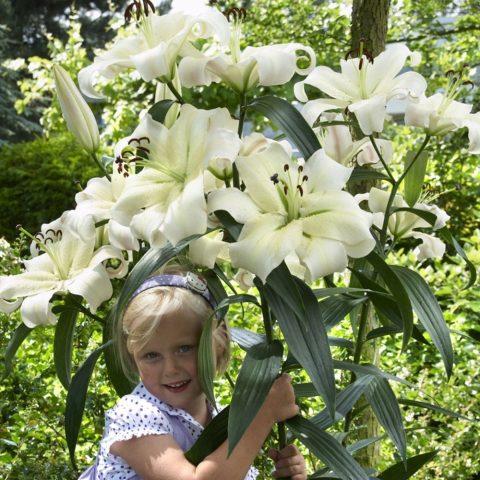
OT hybrids – giant lilies
The best varieties of OT-lily hybrids with photos
Today, OT hybrids include a large number of beautiful varieties, each of which has stunning flowering. They come in a wide range of colors and may differ in stem height and inflorescence shape. Among them there are also both absolutely unpretentious species and those requiring increased attention. The most beautiful OT hybrids of lilies, their descriptions and photos can be found below.
Anastasia
Anastasia - the variety is a tall plant from 120 to 180 cm in length. The petals of the buds of the variety are curved, pink and white in color, and have a very pleasant aroma.
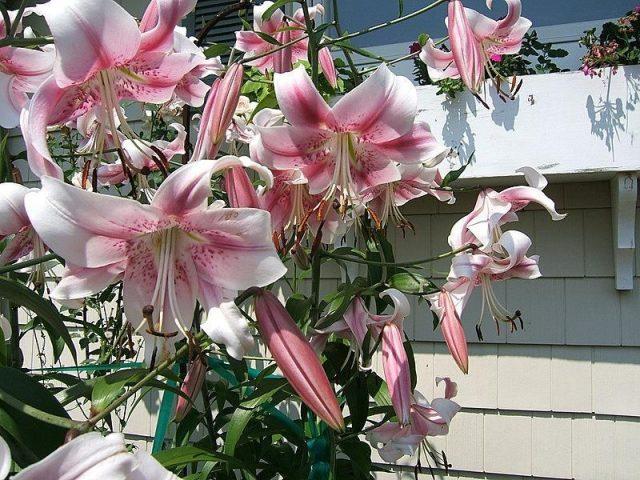
Lily Anastasia came from a backcross of Alegra
Bonbini
Bonbini are star-shaped cream-colored buds with a pink edging in the central part. The inflorescences are pyramidal, collected on a stem up to 250 cm high.
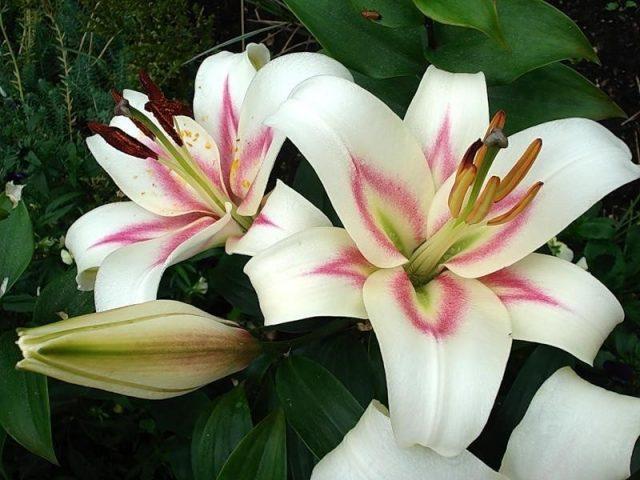
Lily Bonbini places high demands on the soil
Boogie Woogie
The Boogie Woogie variety, compared to others, is considered low-growing; its stem usually does not exceed 1 m in length. The flowering is white and pink. The inflorescences are directed in different directions.
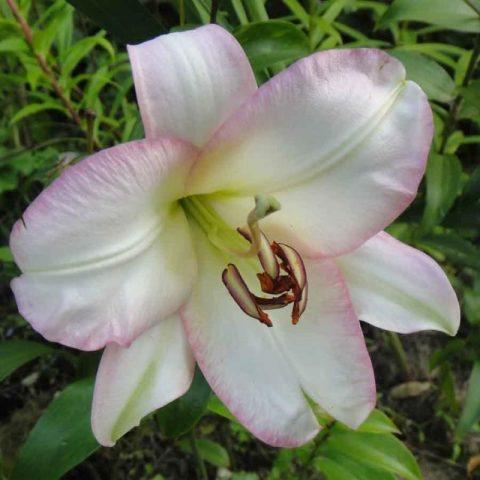
The aroma of Boogie Woogie is very similar to the smell of lilies of the valley
Debbie
Debby is a tall variety of OT hybrid, the stem length of which is about one and a half meters. The buds are large (20 cm), exude a pleasant aroma, and are wine-colored with a salmon stripe.
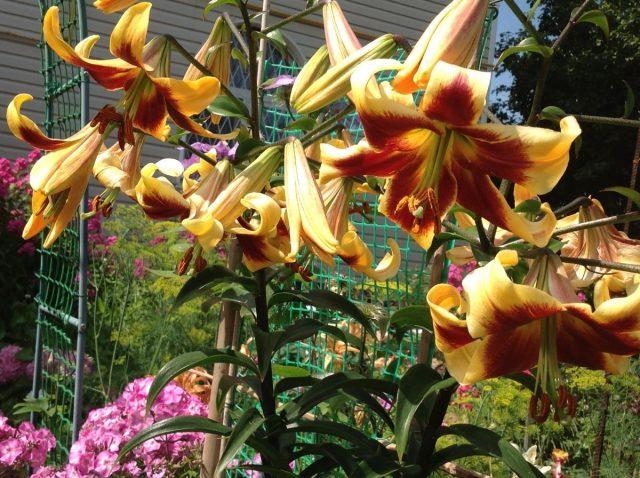
Debbie shows off her charm in the sunny flowerbeds
Eastern Moon
Eastern Moon is a variety of OT-hybrid lily with dense foliage and an erect stem, which can grow up to 2.5 m in length. The color of the variety is different: white, pink, orange, yellow. There are lilac specimens with stripes or specks.
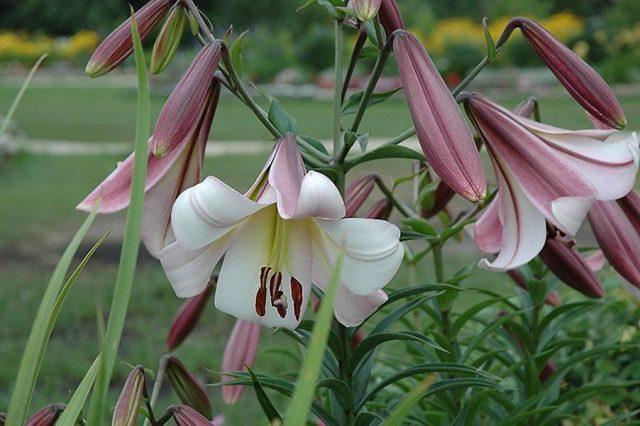
Eastern Moon flowers are single or collected in small inflorescences
Lavon
OT-hybrid Lavon is a spectacular variety with white buds with pink-red stripes. The petals are slightly bent.
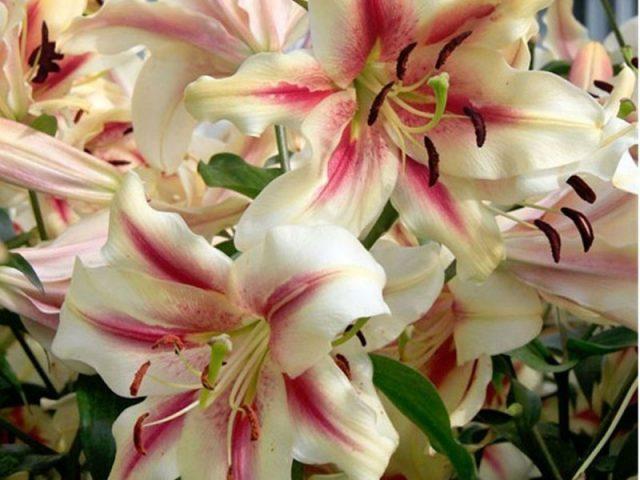
One Lavon stem can accommodate up to 30 buds
Manissa
Manissa is an OT hybrid with funnel-shaped buds that are directed in different directions. The color scheme is expressed in a soft yellow tone, but as it approaches the center the color becomes brighter. Plant height is about 120 cm.
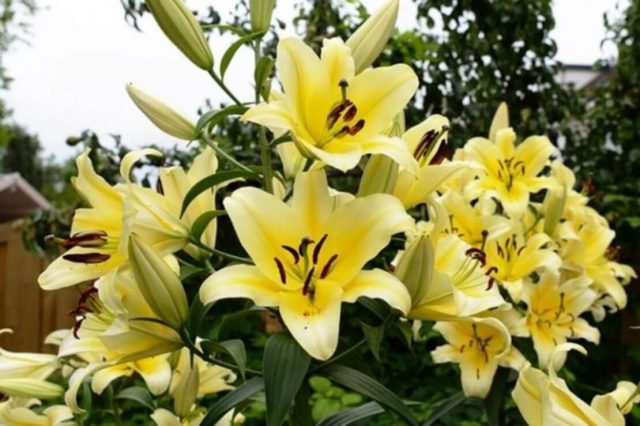
Manissa exudes a bright aroma
Miss fairy
Miss Feya is an OT-hybrid lily variety with large buds (25 cm) of bright red color with a white border.The flower is equated to trees, since in a favorable environment it can grow up to 250 cm.

Miss fairy stems are distinguished by their increased strength
Mister Cas
Mister Cas - a distinctive feature of the variety is that its flowers have incredible elegance and aroma. The color of the buds is white with yellowness, the inflorescences are directed downwards. The height of the variety is usually 1.2 m.
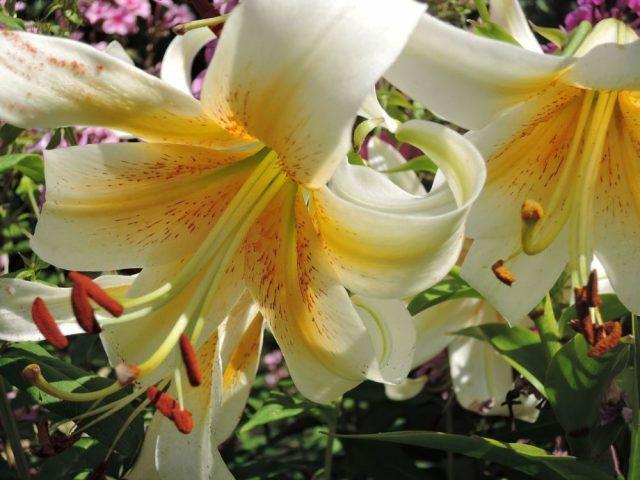
Graceful Mr. Cus petals with waves
Pretty Woman
Pretty Women is a tall lily with very large buds, the diameter of which can reach 30 cm. The color is white or cream, funnel-shaped.
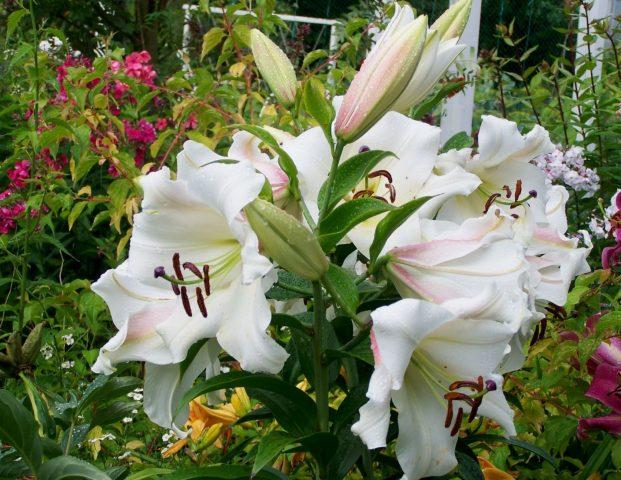
Pretty Woman is easy to cultivate and is very popular among gardeners.
Robert Swanson
OT-hybrid Robert Swanson is presented in an original color scheme: purple in the central part, yellow at the edges.
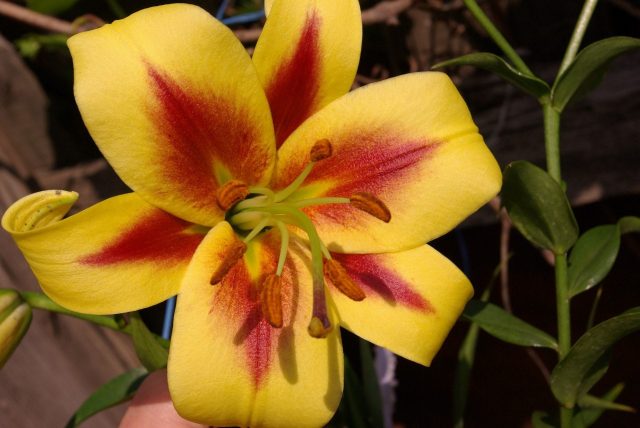
Each inflorescence Robert Swanson consists of several flowers
Saltarello
Saltarello is an OT hybrid up to 150 cm high. The buds are yellow with a salmon tint, quite large, at least 20 cm in diameter. Their shape is cup-shaped.
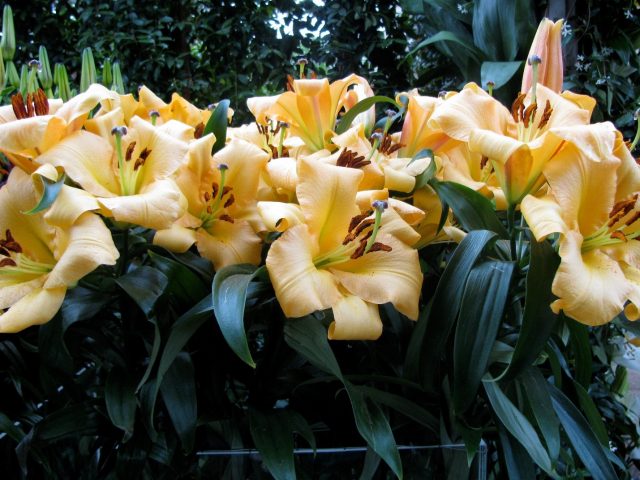
Saltarello lilies have a strong but pleasant aroma
Friso
Friso (Friso) is a hybrid up to 1.3 m high with tubular flowers directed to the sides. The color of the buds is cream, with a raspberry center. Diameter about 19 cm.
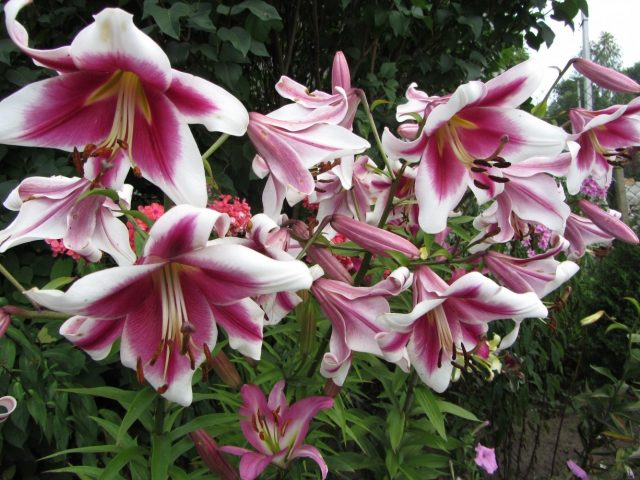
The ends of the Friso petals are wavy and slightly curved
Features of growing OT-lily hybrids
Extensive experience in growing OT-hybrid lilies has proven that the variety feels best in loose soil with a drainage layer and a high level of nutrition.
Planting of OT-hybrid lilies is carried out in the spring or at the end of September in well-dug (0.5 m) soil mixed with peat, humus, wood ash, potassium sulfate and superphosphate. Moreover, the amount of substances added to the soil depends on the type and initial composition of the soil. The place should be well-lit, without strong wind, but with good air circulation. After planting, the flowerbed with lilies is mulched with peat and standard care is carried out:
- water moderately, as needed;
- periodically loosen the soil and remove weeds;
- fertilize at least three times per season with mineral and organic compounds;
- For winter, cut to a height of 7-10 cm and cover.

OT hybrid lilies can grow in one place for three to five years
Reproduction of OT hybrids of lilies
Many OT hybrid lily varieties are easy to propagate. There are many methods that are suitable for breeding crops:
- bulbs;
- cuttings;
- scales;
- seeds.
The easiest way to propagate OT-hybrid lilies is by division, when small tubers appear on the mother bulb. To do this, dig up a 3-4 year old plant, carefully disconnect the small children and plant them in pre-prepared holes.
To carry out flower cuttings, part of the stem with buds is cut from the plant, the leaves are torn off and planted in the ground. When, after 30-50 days, the plant forms bulbs, they are planted for germination.
The lily is also propagated by scales, for which they are detached from the bulb (2-3 pieces), placed in the ground and covered with sawdust.With regular moisture, within a few months the plant produces a stem with leaves.
Seeds of OT-lily hybrids are also quite easy to propagate, but this method, unlike the previous ones, takes a lot of time. Sowing is carried out in the fall according to the standard scheme, then care is taken and the resulting bulbs are planted in the ground next year.
Diseases and pests
Lilies OT-hybrids have average resistance to diseases. They suffer from infrequent diseases, mainly from rot, fusarium, rust, and mosaic. To prevent diseases, the bulbs and the plants themselves are treated with Fundazol or Bordeaux mixture for preventive purposes.
The pests that most often attack OT hybrid lilies are aphids, leaf beetles, and red beetles. From time to time they must be treated with insect repellents:
- heads - Karbofos or Fundazol;
- shoots - with copper oxide or Bordeaux mixture.
Application in landscape design
OT-hybrid lilies look good both in group and single plantings. You can create unusual and bright flower beds from different varieties on your site. The plant is placed at the facade of the house, along paths and alleys, in the background of low-growing ornamental plants. They look great against the background of any greenery, the main thing is not to forget that their height will be quite large. Often, OT hybrids are planted together with other types of lilies, surrounded by smaller varieties, and combined with ferns, juniper, delphinium, and astilbe.

OT-hybrid lilies are suitable for cutting and making bouquets
Conclusion
OT-hybrid lilies look great in gardens and flower beds of different styles. They have incredible charm, smell nice, and have good durability.The variety is recognized as optimal for cultivation in Russian regions. With proper care, it will delight the gardener with its wonderful appearance for many years.
Reviews of lilies OT-hybrid








